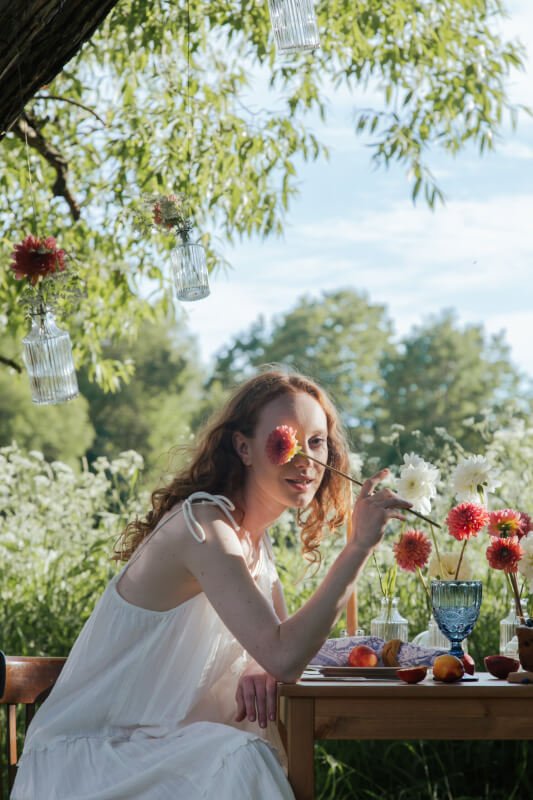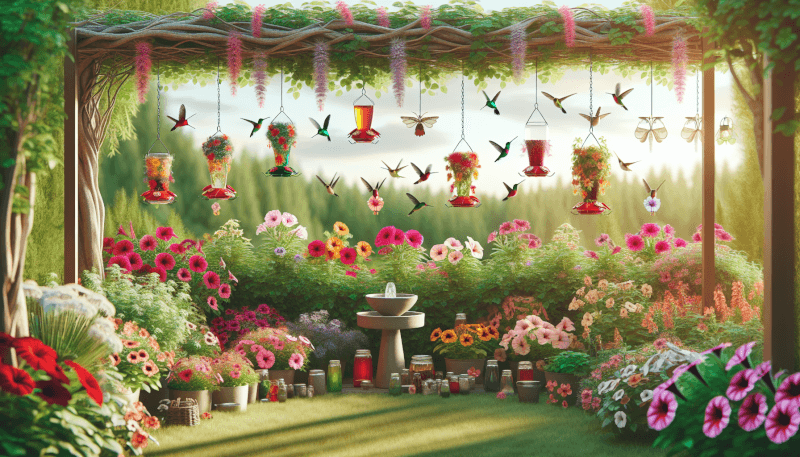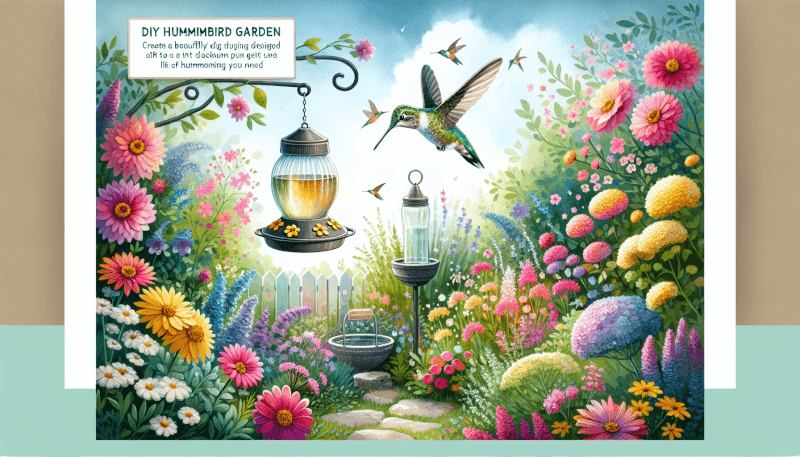Are you looking to bring more color and beauty to your garden while attracting some vibrant visitors? Look no further than creating your own DIY Hummingbird Garden. With their iridescent feathers and delicate charm, these tiny birds add a touch of magic to any outdoor space. In this article, you will discover the top ways to design a DIY Hummingbird Garden that will not only provide a haven for these delightful creatures but also create a wonderful oasis for you to enjoy.

Choosing the Right Location for Your Hummingbird Garden
Sunlight and Shade
When selecting a location for your hummingbird garden, it is essential to consider the amount of sunlight and shade the area receives. Hummingbirds are attracted to areas that provide a balance between direct sunlight and shade. Ideally, your garden should receive around six hours of sunlight each day, especially during the morning and late afternoon. However, it is equally important to have some shaded areas where the hummingbirds can rest and cool down during the hottest parts of the day.
Protection from Wind
Hummingbirds are delicate creatures, and strong winds can make it challenging for them to fly and feed. It is important to choose a location for your garden that offers some protection from gusty winds. Planting your garden near fences, buildings, or hedges can provide natural wind barriers and create a more inviting environment for hummingbirds. Additionally, placing your feeders and flowering plants in more sheltered areas can help the birds feel more secure and at ease.
Accessibility for Hummingbirds
Another crucial aspect to consider when choosing a location for your hummingbird garden is the accessibility for the birds. Hummingbirds need clear flight paths, so it is best to avoid congested areas or locations with too many obstacles. Aim for a spot that allows the hummingbirds to approach and leave the garden with ease. Additionally, consider the proximity to other natural food sources like trees, shrubs, or open fields, as this can make your garden more appealing and increase the chances of attracting these beautiful birds.
Selecting the Best Plants for Your Hummingbird Garden
Native Flowers
When it comes to selecting plants for your hummingbird garden, native flowers should be at the top of your list. Native flowers are not only well-adapted to the local climate and soil conditions but are also more likely to attract native hummingbird species. These flowers have evolved alongside hummingbirds, making them an excellent source of nectar for these vibrant birds. Some popular native flowers that hummingbirds love include bee balm, cardinal flower, and trumpet vine.
Brightly Colored and Fragrant Flowers
Hummingbirds are highly attracted to bright colors and strong fragrances. When choosing flowers for your garden, opt for plants that have vibrant red, orange, or purple blossoms. These colors are known to catch the attention of hummingbirds, as they associate them with nectar-rich flowers. Additionally, selecting flowers with strong aromas can further entice hummingbirds to visit your garden. Consider adding plants like jasmine, honeysuckle, or lilac to provide both visual and olfactory delights for these tiny birds.
Tubular-Shaped Flowers
One characteristic that hummingbirds find irresistible in flowers is their shape. Hummingbird-adapted flowers are typically tubular in shape, allowing the birds to easily access the nectar with their long beaks and tongues. Look for plants such as salvia, penstemon, or fuchsia, as they possess the ideal tubular structures that can accommodate hummingbirds. By including these types of flowers in your garden, you will create a welcoming environment tailored to the feeding preferences of these incredible creatures.
Continuous Blooming Plants
To ensure a consistent food source for hummingbirds throughout the season, it is essential to incorporate plants that bloom at different times. This will provide a steady supply of nectar and keep the hummingbirds coming back to your garden. Choose a variety of plants with staggered blooming periods, including early spring, summer, and fall. By carefully selecting and planning for continuous blooms, you can create a hummingbird garden that sustains these birds throughout their migration and breeding cycles.

Providing Water Sources for Hummingbirds
Birdbaths and Water Fountains
In addition to nectar-rich flowers, hummingbirds also require a source of water for drinking and bathing. Including birdbaths or water fountains in your garden can attract these birds and provide them with a much-needed hydration spot. When selecting a birdbath, ensure it is shallow with a gradual slope to allow the hummingbirds to safely perch and bathe. Keep the water clean and replace it regularly to prevent the spread of diseases or parasites. Adding a small fountain or misting feature to the water source can also increase its attractiveness to hummingbirds.
Misting Systems
Hummingbirds enjoy flying through fine water droplets, and a misting system can mimic the natural dew found on flowers. Installing a misting system in your garden can provide a refreshing and stimulating experience for the birds. The mist encourages hummingbirds to fly through it, allowing them to cool down and clean their feathers simultaneously. However, be mindful of the water pressure, as a high-pressure misting system may startle or intimidate the birds. Opt for a gentle mist that replicates a light rain shower instead.
Water Drips or Drippers
Another way to offer water to hummingbirds is by utilizing water drips or drippers. These small devices attach to a hose or faucet and create a slow and continuous drip that resembles natural water droplets from leaves or flowers. Hummingbirds are instinctively attracted to these tiny movements and will perceive the drips as a reliable water source. Place the drippers near flowering plants to create an inviting atmosphere for the birds. Regularly check and clean these devices to ensure a steady and clean water supply for your hummingbird visitors.
Creating Shelter and Nesting Areas
Adding Trees and Shrubs
To create a hummingbird-friendly habitat, it is important to incorporate trees and shrubs into your garden. These tall and dense vegetation structures provide shelter, perching spots, and potential nesting locations for the birds. Native trees and shrubs are especially beneficial, as they offer familiarity and natural food sources for hummingbirds. Include plants like red cedar, elderberry, or pine to provide year-round cover and nesting options for these tiny creatures.
Installing Nesting Boxes
Hummingbirds are known to build their nests in a variety of locations, including trees, shrubs, and even man-made structures. Installing nesting boxes specifically designed for hummingbirds can provide ideal nesting opportunities and attract these birds to your garden. Locate the nesting boxes in sheltered areas, away from direct sunlight and potential predators. Keep in mind that different species of hummingbirds have specific preferences in terms of nest height, entrance size, and shelter, so research the needs of your local hummingbird species when selecting and placing nesting boxes.
Offering Natural Material for Nest-Building
Hummingbirds construct their nests using various natural materials, including spider silk, moss, and plant fibers. By providing readily available nesting materials in your garden, you can assist these amazing birds in their nest-building process. Place small piles of twigs, small branches, or soft plant materials like dandelion fluff within easy reach of the hummingbird nesting areas. Observing a hummingbird gathering materials or building its nest can be a rewarding and fascinating experience for any bird enthusiast.

Including Feeders in Your Hummingbird Garden
Different Types of Feeders
Hummingbird feeders are a popular and effective way to provide a readily available food source for these birds. When selecting feeders for your garden, consider the different types available. Traditional feeders consist of bottles or tubes with feeding ports, allowing the birds to access the sugar-water solution. There are also saucer-style feeders that provide a larger perching area for hummingbirds. Experiment with different feeder designs to determine which style attracts the most hummingbirds to your garden.
Placing Feeders at Optimal Locations
The placement of your hummingbird feeders is crucial for attracting and accommodating these birds. First and foremost, it is important to position the feeders away from windows to prevent bird collisions. Place the feeders in partially shaded areas, as direct sunlight can cause the sugar-water solution to spoil more quickly. Hang the feeders at a height that allows easy access for both adult and juvenile hummingbirds. Finally, consider placing multiple feeders throughout your garden to prevent territorial disputes and provide sufficient feeding opportunities.
Feeder Maintenance and Cleaning
Regular maintenance and cleaning of hummingbird feeders are essential to ensure the health and well-being of the birds. Hummingbird feeders should be cleaned every few days to prevent the growth of mold and the presence of harmful bacteria. Use hot water and a mild detergent to thoroughly clean the feeder, rinsing it well before refilling with fresh nectar. In warmer climates, it is especially important to monitor the feeder daily to ensure the nectar remains fresh and uncontaminated. By maintaining clean and well-supplied feeders, you will encourage hummingbirds to visit your garden regularly.
Balancing Open Areas and Vegetation in Your Garden
Creating Clear Flight Paths
To facilitate easier navigation and flight for hummingbirds, it is crucial to create clear flight paths within your garden. Avoid cluttering the space with excessive decorations, furniture, or obstructions that may obstruct the birds’ movement. Plan your garden layout in a way that allows hummingbirds to fly freely and access the various feeding and nesting areas without encountering unnecessary obstacles. By providing unobstructed flight paths, you will create a safe and inviting environment for the birds.
Providing Perches for Hummingbirds
While hummingbirds are known for their aerial agility, they also require perches to rest, preen, and guard their territory. Incorporate natural perching spots into your garden by planting trees or installing small branches or poles. Ideally, these perching areas should be located near feeders, flowering plants, or water sources. Providing perches not only offers hummingbirds a place to recharge their energy but also allows you to observe these marvelous birds up close as they rest and display their vibrant plumage.

Using Natural Pest Control Methods
Companion Planting
One effective way to naturally control pests in your hummingbird garden is through companion planting. By strategically planting certain flowers and herbs, you can deter unwanted insects and pests while attracting beneficial ones that help create a balanced ecosystem. For example, marigolds can repel aphids, while lavender or mint can deter mosquitoes. Research companion plants that can help deter specific pests common in your area and integrate them into your garden design to keep pests at bay without resorting to harmful chemicals.
Attracting Beneficial Insects
Encouraging beneficial insects in your garden can significantly contribute to pest control while benefiting your hummingbird visitors. Ladybugs, lacewings, and hoverflies, for example, feed on aphids and other harmful insects. Planting flowers like yarrow, goldenrod, or daisies can attract these beneficial insects, providing them with a food source and encouraging them to take up residence in your garden. By fostering an environment that supports beneficial insects, you can help maintain a healthy balance while minimizing the need for chemical pest control methods.
Avoiding Harmful Chemicals
When cultivating a hummingbird garden, it is essential to prioritize the health and well-being of the birds by avoiding harmful chemicals. Pesticides and herbicides can have adverse effects not only on insects but also on hummingbirds themselves. Instead of relying on chemical-based products, explore organic or natural alternatives for pest control. Additionally, opt for natural fertilizers and soil amendments to maintain soil health. By minimizing the use of harmful chemicals, you create a safer environment for the birds and maintain their natural behaviors.
Implementing Garden Design Techniques
Grouping Plants with Similar Water Needs
Efficient water usage is crucial for maintaining a thriving hummingbird garden. When planning your garden layout, consider grouping plants with similar water needs together. This practice allows for more efficient irrigation, preventing water waste and ensuring each plant receives the appropriate amount of moisture. By grouping plants with similar water requirements, you can optimize water usage, reduce maintenance efforts, and create a healthier garden environment for both hummingbirds and plants.
Utilizing Color Combinations
The color palette of your hummingbird garden is an essential aspect of its overall design and attractiveness to the birds. Thoughtfully selecting color combinations can enhance your garden’s visual appeal and attract more hummingbirds. Red, orange, and pink flowers are known to be especially attractive to hummingbirds, whereas purple and blue flowers can be less appealing. Aim for a mix of vibrant hues and complementary color combinations to create an eye-catching and enticing display of flowers that will catch the attention of these energetic birds.
Creating Different Heights and Layers
To create visual interest and increase the diversity of your hummingbird garden, incorporate plants with different heights and layers. By creating vertical structures, such as tall trees or trellises covered with climbing vines, you can provide additional perching opportunities for the hummingbirds. Integrate shorter plants and ground covers to complement the taller features and create a layered effect within your garden. This approach not only adds depth and variety but also attracts a wider range of hummingbird species that may prefer different levels within the garden.

Ensuring Proper Garden Maintenance
Regular Weeding and Pruning
Regular maintenance, including weeding and pruning, is essential to keep your hummingbird garden healthy and thriving. Weeds can compete with your chosen plants for water, sunlight, and nutrients, and it is important to remove them to prevent the garden from becoming overgrown or overcrowded. Pruning plants, especially those that bloom continuously, can encourage new growth and prolong the flowering period. Additionally, removing dead or diseased vegetation can help prevent the spread of diseases and maintain a clean and inviting environment for hummingbirds.
Watering and Fertilizing
Proper watering and fertilizing are vital for the overall health and vigor of your garden. Different plants have varying water requirements, so ensure you provide the appropriate amount of water for each species. Avoid overwatering, as it can lead to root rot and attract harmful pests. When fertilizing, opt for organic or slow-release fertilizers to avoid chemical runoff and potential harm to the birds. Regularly monitor the moisture levels, soil quality, and nutrient levels in your garden to ensure optimal growing conditions for both plants and hummingbirds.
Monitoring Hummingbird Activity
Keeping an eye on hummingbird activity in your garden is an exciting and insightful part of maintaining a hummingbird garden. Monitor the presence and behaviors of the birds, noting any changes in feeding patterns or territorial behavior. This can help you assess the success of your garden design, identify any potential issues, and make adjustments accordingly. By observing and understanding hummingbird behavior, you can continuously improve your garden to better accommodate these amazing creatures and maximize the enjoyment of their presence.
Observing and Enjoying Hummingbirds
Setting Up Bird-Watching Stations
To fully appreciate the beauty and wonder of hummingbirds, create designated bird-watching stations in your garden. This can be as simple as placing a comfortable chair or bench in a strategic location that offers a clear view of the hummingbird activity. Consider adding a small table to hold binoculars, a bird identification book, or a camera. By dedicating specific areas for observation, you can spend moments of tranquility and enjoyment in the presence of these charming birds.
Photographing and Documenting Hummingbirds
Capture the magic of hummingbirds by photographing and documenting their visits to your garden. Invest in a quality camera with a zoom lens to capture detailed shots of these fast-moving birds. Patience and persistence are key when photographing hummingbirds, as they are incredibly swift and agile. Take time to learn their patterns and behaviors, experimenting with different camera settings and angles. Documenting your encounters with hummingbirds can create lasting memories and provide valuable information for further research or sharing with fellow bird enthusiasts.
Providing Seating and Relaxation Areas
Hummingbird gardens are not only a space for the birds but also a sanctuary for relaxation and enjoyment. Incorporate seating areas or create cozy nooks within your garden where you can sit, unwind, and appreciate the presence of these captivating creatures. Add comfortable seating options such as benches, hammocks, or loungers and surround yourself with the beauty and tranquility of your hummingbird garden. Whether reading a book, sipping a cup of tea, or simply absorbing the sights and sounds of nature, these relaxation areas allow you to fully immerse yourself in the experience of your hummingbird garden.
In conclusion, designing a hummingbird garden is an enjoyable and rewarding endeavor. By carefully considering factors such as sunlight and shade, plant selection, water sources, shelter, feeders, garden maintenance, and observing hummingbirds, you can create a haven that attracts and supports these delightful birds. With the right combination of flowers, water features, perching spots, and careful planning, you can create a hummingbird-friendly garden that brings joy, beauty, and a sense of wonder to both you and your feathered visitors. Happy hummingbird gardening!


